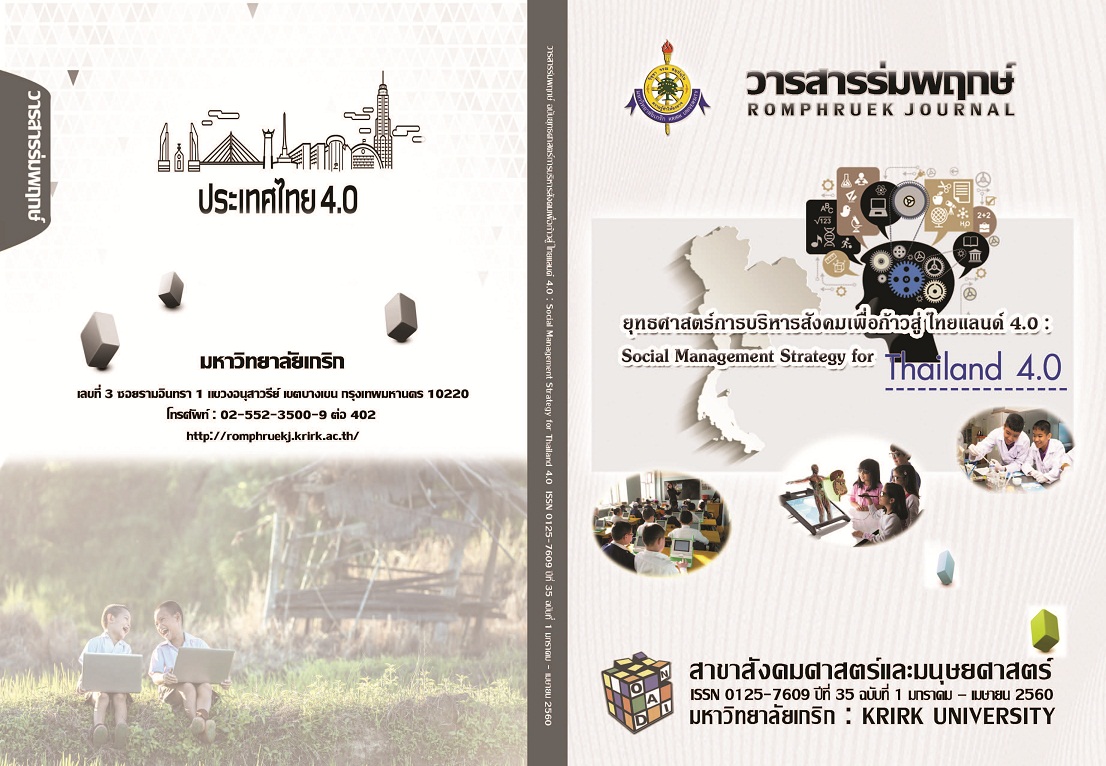Development of Food Preservation and Processing for Thailand 4.0
Main Article Content
Abstract
The objective of this article was to introduce the importance and the development of food preservation and processing for Thailand 4.0. Food preservation and processing can eliminate, inhibit or destroy microorganisms and toxins created by microorganisms. Food can be stored for a long time, reduce overcapacity and food shortage, have food to consume all seasons and be convenient for transportation. It also creates new product according to the needs of consumers and adding value to food products. Preservation and processing of food are among key factors in the development of innovative food for Thailand 4.0. Currently, Thailand is focusing on building a “Food Innopolis”, through which more funding for research, development of food preservation and processing, connectivity of local business in the food supply chain to the international markets, and adding value to food products and services are allocated so that these undertakings could become one of the important economic engines leading Thailand to the status of being the “World Kitchen.” These developments could not be possible without the cooperation from all sectors, namely, government, business, citizen and educational institutes. These sectors must be “aware and collaborate” by conducting research, both locally and internationally, toward knowledge management. Determined and continued applications of these knowledge to gain best practices and innovation are essential for a balanced, successful, wealthy, secured and sustainable Thailand to gain the status of a value-based economy of Thailand 4.0.
Article Details
Every article published in the Romphruek Journal of the Humanities and Social Sciences is the opinion and point of view of the authors. Thery're not the viewpoint of Krirk University or the editored department. Any part or all of the articles for pablication must be clearly cited.
References
จันทนี ธีรเวชเจริญชัย. (2557). การพัฒนาอาหารว่างแบบเลเยอร์ที่เบต้าแคโรทีนจากฟักทอง มันเทศ และแครอท. คณะอุตสาหกรรมเกษตร มหาวิทยาลัยเกษตรศาสตร์, กรุงเทพฯ.
ชลลดา ดวงปิ่น. (2557). กระบวนการผลิตไข่ขาวเค็มผงโดยการทำแห้งแบบโฟมแมทและการนำไปใช้ประโยชน์. คณะอุตสาหกรรมเกษตร สถาบันเทคโนโลยีพระจอมเกล้าเจ้าคุณทหารลาดกระบัง, กรุงเทพฯ.
ญาณิศา รัตนธานันท์. (2557). การคงสภาพและปรับปรุงลักษณะทางกายภาพของรำข้าวเพื่อใช้เป็นผลิตภัณฑ์มูลค่าสูง. คณะอุตสาหกรรมเกษตร มหาวิทยาลัยเชียงใหม่, เชียงใหม่.
นวัตกรรมเพื่ออาหาร 4.0 หนุนแบรนด์ไทยสู่ตลาดโลก. (25 ธันวาคม 2559). สืบค้นจาก http://www.newsplus.co.th/119207.
ประชาชาติธุรกิจออนไลน์. นวัตกรรมถนอมอาหาร Kryo “D” Freezer. (25 ธันวาคม 2559). สืบค้นจาก http://www.prachachat.net/news_detail.php?newsid=1480852237.
ประเทศไทย 4.0 Thailand 4.0 คือ. (14 ธันวาคม 2559). สืบค้นจาก http://www.admissionpremium.com/news/1377.
มลิวรรณ อุดทะยอด. (2557). ผลการใช้แป้งถั่วแดงทดแทนแป้งสาลีต่อคุณภาพของขนมปังแซนด์วิช. คณะอุตสาหกรรมเกษตร สถาบันเทคโนโลยีพระจอมเกล้าเจ้าคุณทหารลาดกระบัง, กรุงเทพฯ.
มหาวิทยาลัยพะเยา, กองบริหารงานวิจัยและประกันคุณภาพการศึกษา. (2559). Thailand 4.0 โมเดลขับเคลื่อนประเทศไทยสู่ความมั่งคั่ง มั่นคง และยั่งยืน. (18 ธันวาคม 2559). สืบค้นจาก http://www.libarts.up.ac.th/v2/img/Thailand-4.0.pdf.
มหาวิทยาลัยสุโขทัยธรรมาธิราช, สาขาวิชามนุษย์นิเวศศาสตร์. (2557). เอกสารการสอนชุดวิชา เทคโนโลยี การถนอมและแปรรูปอาหาร (พิมพ์ครั้งที่ 2). นนทบุรี : สำนักพิมพ์มหาวิทยาลัยสุโขทัยธรรมาธิราช.
ส่งชัย จันทร์หา. (2555). การพัฒนาเครื่องบด-หั่นเนื้อสัตว์สำหรับการแปรรูปในอุตสาหกรรมการถนอมอาหาร. คณะเทคโนโลยีอุตสาหกรรม มหาวิทยาลัยราชภัฏกําแพงเพชร, กำแพงเพชร.
สถาบันวิจัยวิทยาศาสตร์และเทคโนโลยีแห่งประเทศไทย. เมืองนวัตกรรมอาหาร. (8 มีนาคม 2560). สืบค้นจาก http://www.tistr.or.th/fff/foodinnopolis.pdf
สถาบันวิจัยวิทยายศาสตร์และเทคโนโลยีแห่งประเทศไทย. (2559). วว.จัดตั้งโรงงานนำร่องมาตรฐานสำหรับผลิตผลิตภัณฑ์เครื่องดื่มสุขภาพและผักผลไม้แปรรูปสนับสนุนโครงการเมืองนวัตกรรมอาหาร. จดหมายข่าว วว, 19(6), 6-8.
สถาบันวิจัยวิทยายศาสตร์และเทคโนโลยีแห่งประเทศไทย. (2560). วว.กับศักยภาพด้านงานวิจัยพัฒนาและบริการทางวิทยาศาสตร์และเทคโนโลยี...ร่วมขับเคลื่อนนโยบายโครงการเมืองนวัตกรรมอาหาร (Food Innopolis). จดหมายข่าว วว, 20(2), 6-8.
สมศักดิ์ คงเที่ยง. (2560). การศึกษาเพื่อประเทศไทย 4.0. วารสารรามคำแหง ฉบับศึกษาศาสตร์, 1(1), 41-49.
สุวิทย์ เมษิณทรีย์. แนวคิดเกี่ยวกับประเทศไทย 4.0. (6 ธันวาคม 2560). สืบค้นจากhttp://planning2.mju.ac.th/goverment/20111119104835_planning/Doc_25590823143652_358135.pdf.
อำไพ ผาสีดา. (2557). การพัฒนาหม้อประกอบอาหารพลังงานแสงอาทิตย์แบบเลนส์รวมแสง. คณะครุศาสตร์ อุตสาหกรรมและเทคโนโลยี มหาวิทยาลัยเทคโนโลยีพระจอมเกล้าธนบุรี, กรุงเทพฯ.
Thailand 4.0. (22 ธันวาคม 2559). สืบค้นจาก https://www.youtube.com/watch?v=OEfY3rQZpNo.
Ministry of Commerce, Department of International Trade Promotion. Infographic: Thailand 4.0 Transforming towards the Value-Based Economy. (28 December 2016). Retrieved from http://www.thaitradeusa.com/home/?p=21763.

